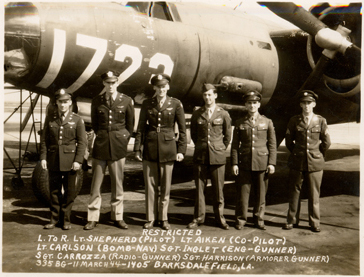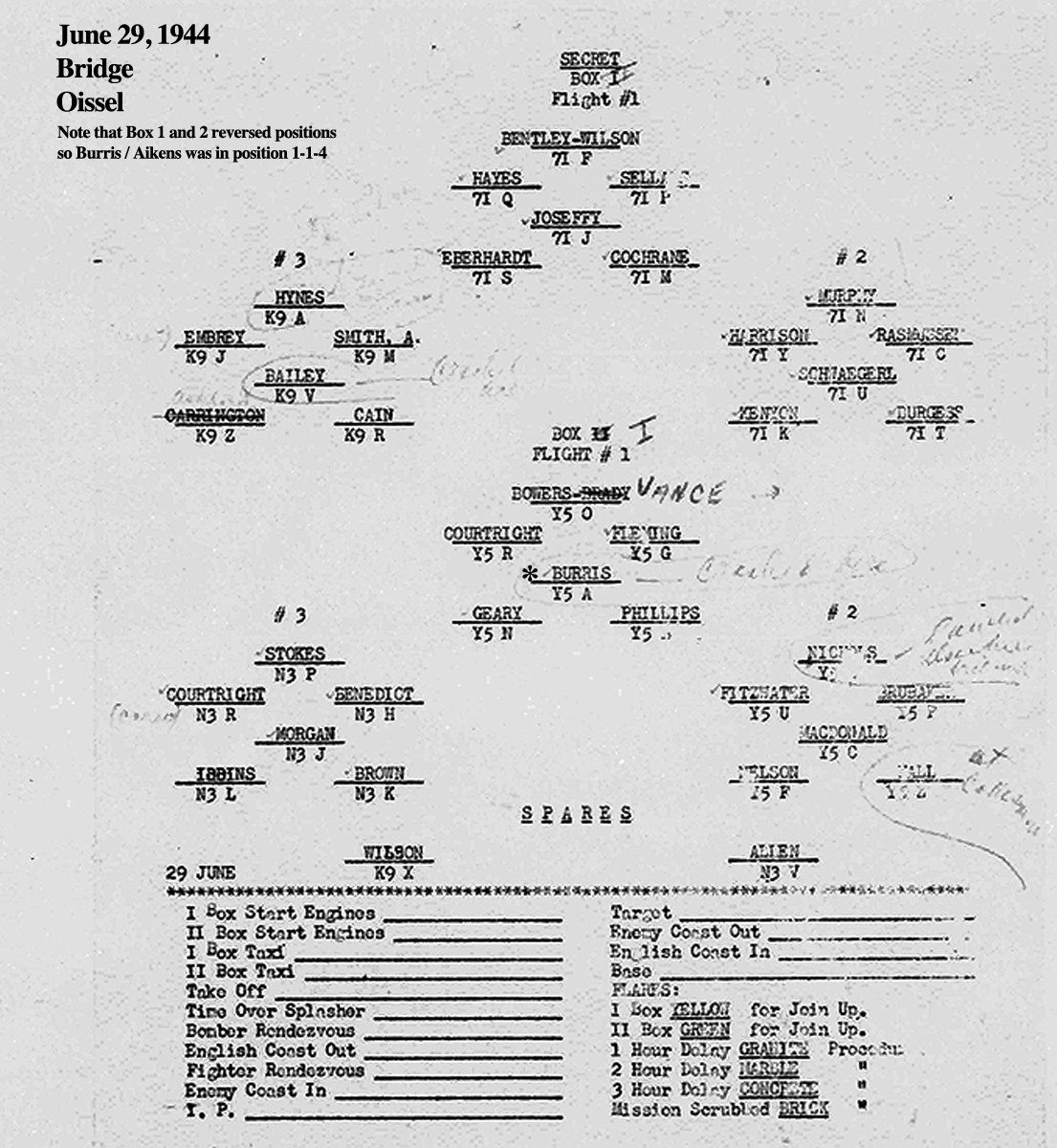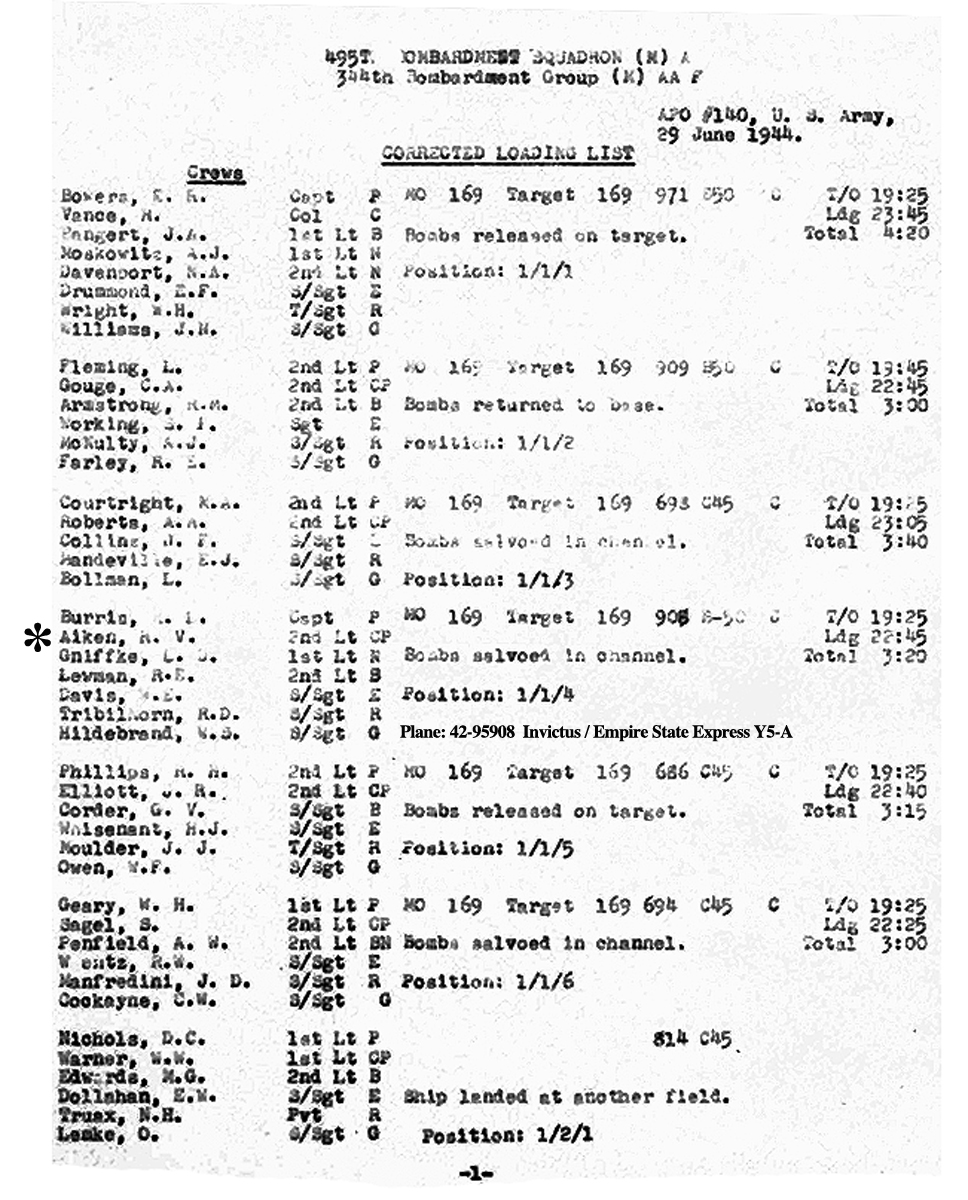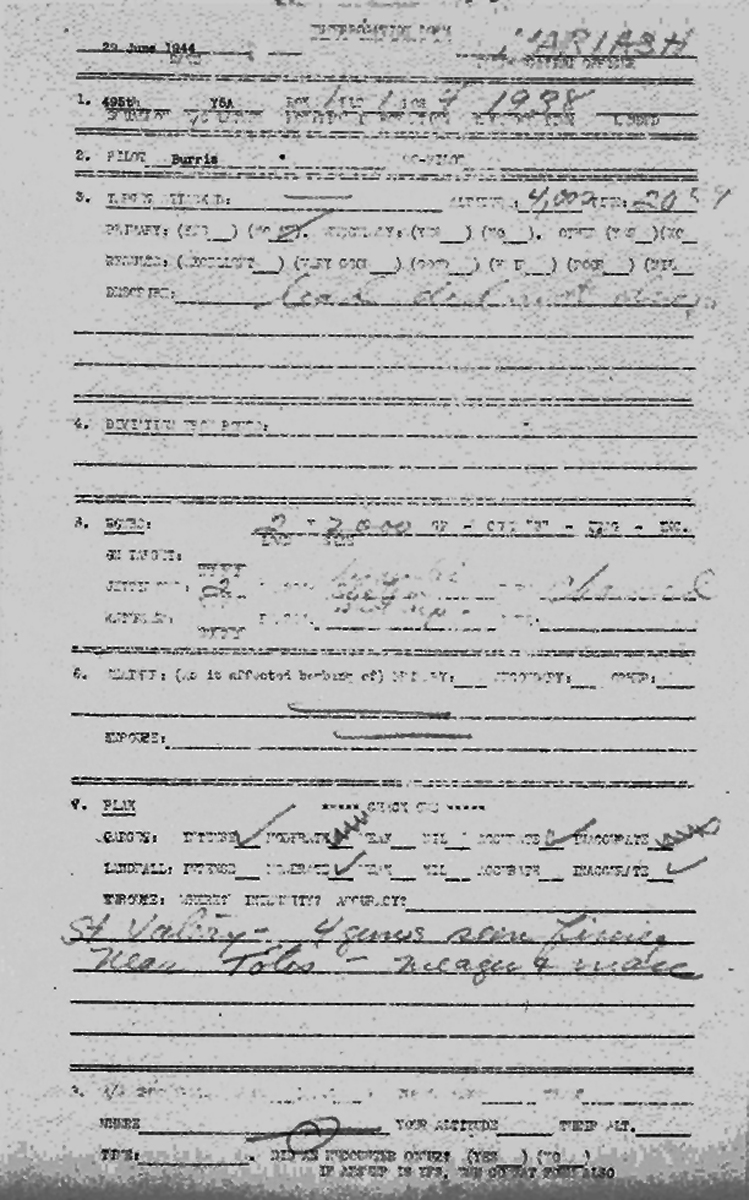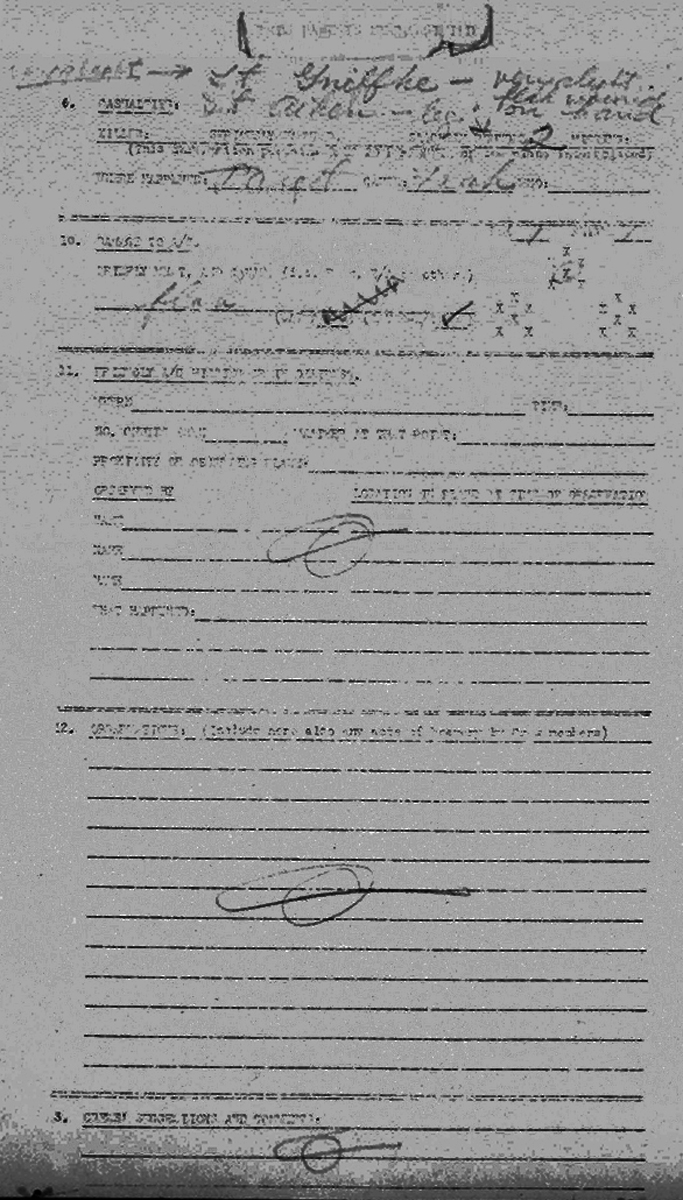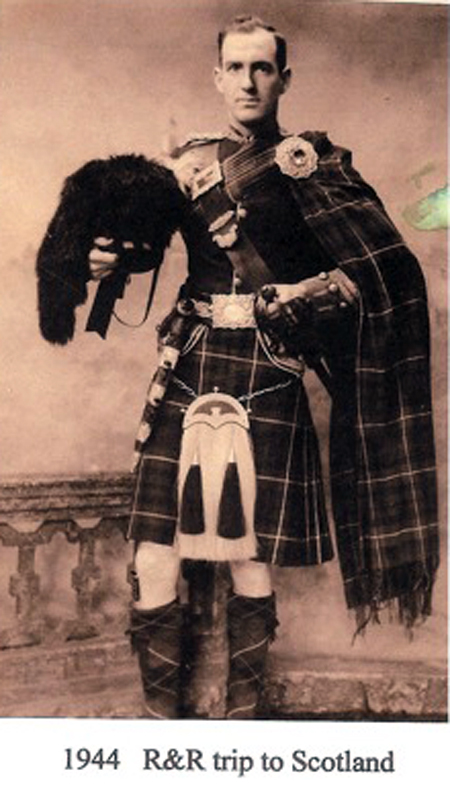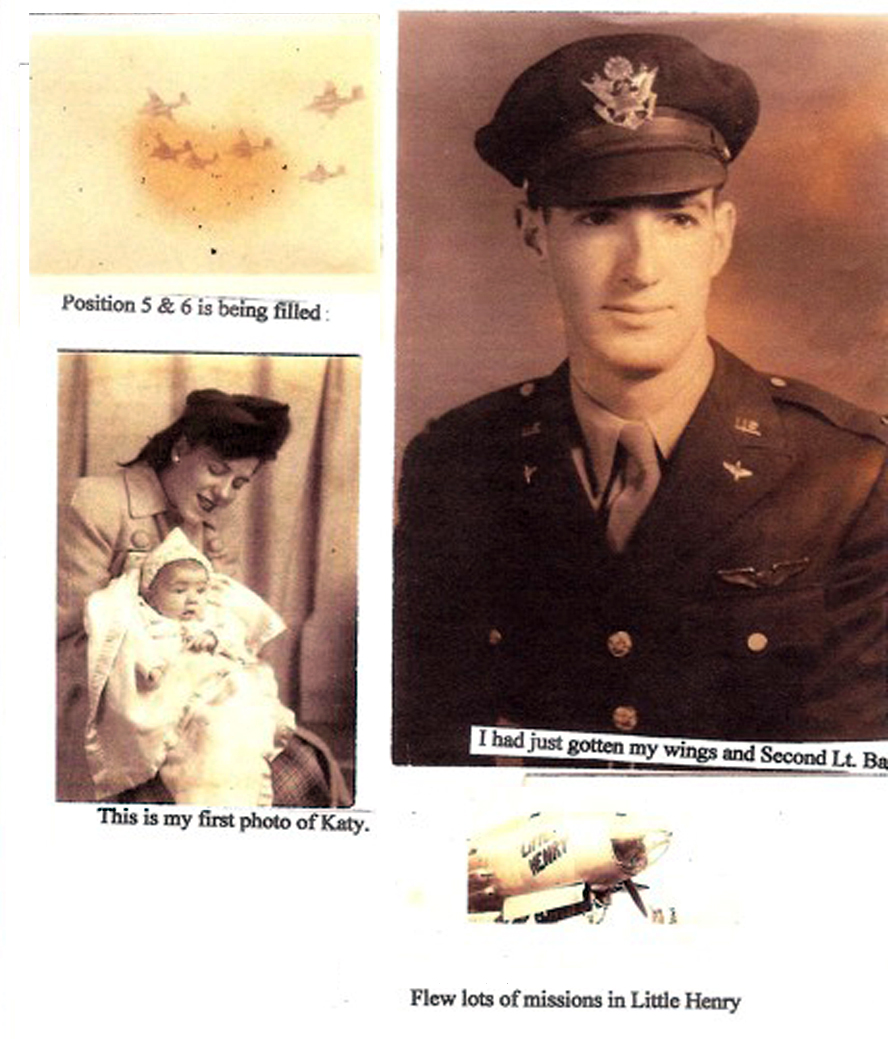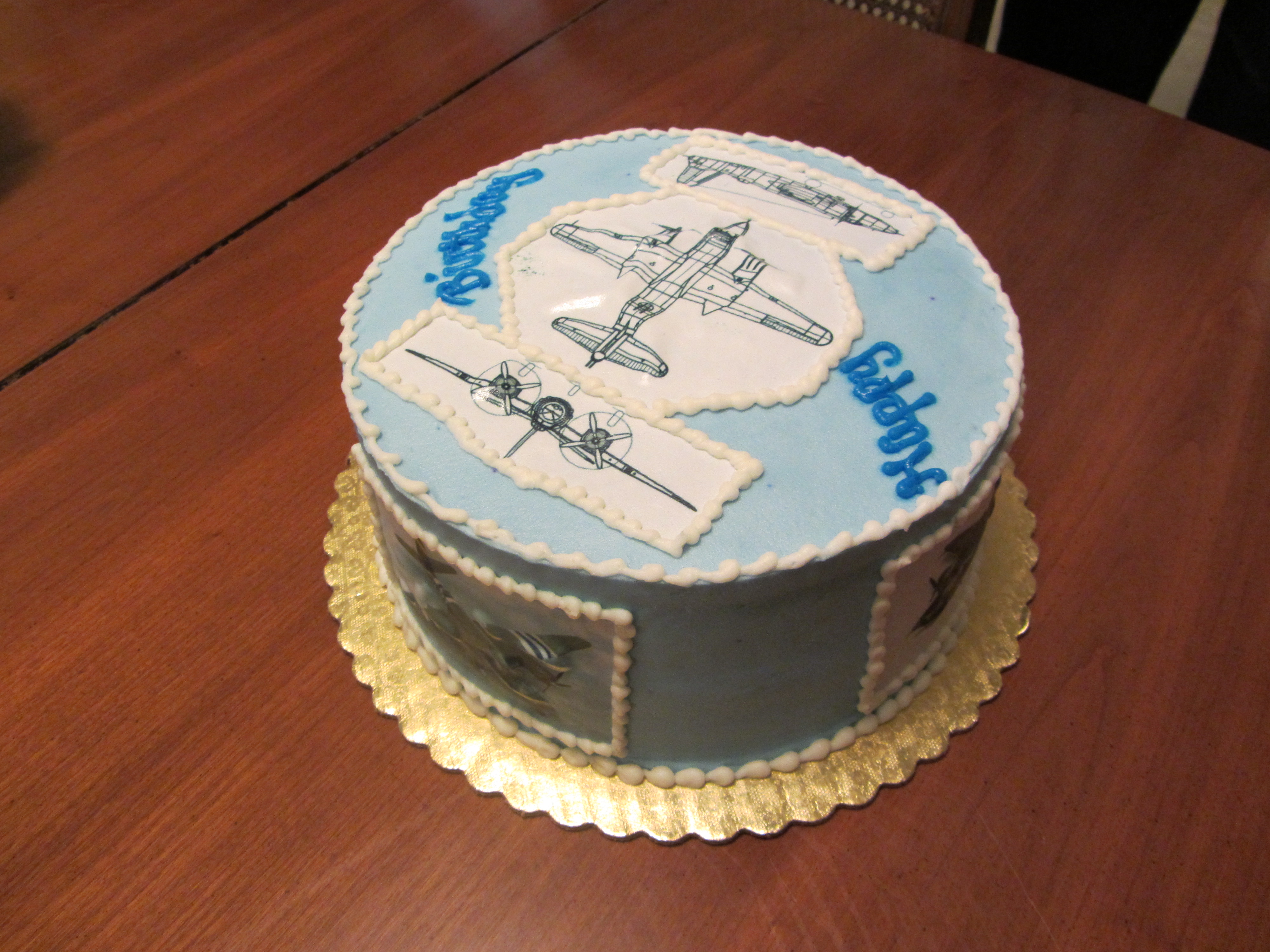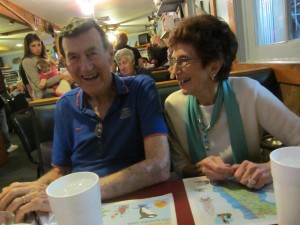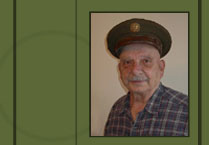Memoirs: Lt. Harold V. Aikens (Dad’s 1st Co-Pilot)
.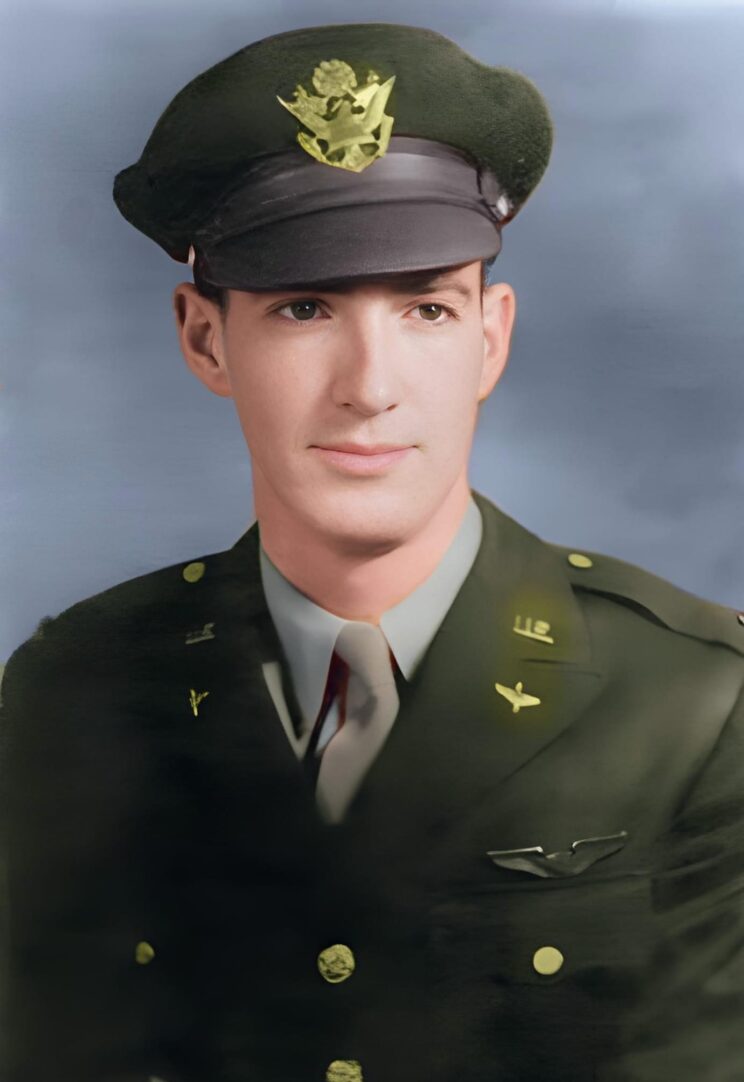
Harold Aiken – colorized and enhanced
Note from Carl Carrozza:
Back on February 6th, 2013 I received a message through this web page that H.V. Aiken was trying to get in touch with me. Again, a needle had jumped out of the haystack! I remembered that Lt. Aiken was my father’s Co-Pilot according to his mission log.Harold Aiken and I continue to correspond and he has sent me lots of information. Some of it fills in some blanks. Some of it was a complete surprise. Some of it contradicts part of the information I got from my father.
The following is an excerpt from Lt. Aiken’s memoirs. I have included the parts that parallel Frank P. Carrozza’s experience. I have inserted some statements and/or colored type in the places where new or different information was revealed to me. .
HAROLD VERNON AIKEN
HISTORY AND EXPERIENCE
Note: The picture above is the same one that my dad had. The two copies of the picture have found each other over space and time. Aiken goes on to say that these men never flew together in combat. He says they only flew a B-26F plane using the “Ferry Route” to Europe. My father’s records have Aiken as my father’s co-pilot several months later. The death of Carlson was described differently on the “Mission Log” part of this web site. I must defer to Mr. Aiken on this. My father left no written record of the death and the oral history I gathered on this might have been confused.………The Base Operations did not know what to do with me. They were trying to find where I should be sent. For 3 months I would report to the base and then go home. We had a 3-month honeymoon. Our quarters varied; Room and bath in a hotel, then room and bath in a private home. In the private home we spent Christmas. Marian found a small Christmas tree, decorated it and placed it on a trunk at the foot of our bed. It was a nice Christmas. We had to eat out for every meal, as there were no cooking facilities available. After Christmas we got a small place with a living room, a Murphy bed, bath and kitchen. Near the middle of Jan. 1944, I called Mother and told her that she was to be a Grandmother. Her response was “Oh Vernon”. Here I was going off to war with a pregnant wife left behind.
CHAPTER 5 ADVANCE MILITARY ACTION
After the three months, I was assigned to the B26 bomber. Barksdale was the operational training place for the B26 bombers. We did some bombing, strafing and formation practice. The instructors were fearful of the new pilots flying formation. We would, jokingly, say that if we were in radio contact we were flying formation. Some of our training at Barksdale was on the firing range. With a shotgun mounted on a torrent, we could shoot clay pigeons. I also had a lot of fun with the 45 automatic that I was issued. Normal trigger pull on the pistol was 6 pounds. I had mine adjusted so that it took only 2 ½ pounds to fire the pistol. I rated Expert with the adjusted trigger pull. I practiced shooting by hitting just under a tin can and keeping it bouncing until I was out of ammunition.
In March of 1944 a group of about 15 crews got orders to go to Hunter Field, GA, for each crew to pick up a new plane and ferry them to Europe. Stopovers were in San Juan, British Ghana, Brazil, Ascension Island, Gold Coast (now Ghana), Segal, and Marrakesh.
The word was that when we stopped in San Juan we should load up on bourbon and leave clothes behind.
The new plane was the model B26“F”. The angle of wing relative to fuselage had been changed. The plane “mushed” until it reached a speed of about 185 mph. “Mushing” is when the tail of the aircraft is low and the nose is higher. The plane is not flying in an efficient attitude. As more power was applied the plane got “over the hump’ the tail comes up and in a more streamline attitude, the plane raced forward. When power was reduced it would start to mush again. It was impossible to fly formation in that model.
Note: I had been trying to find out if dad flew the Shopworn Angel over from the states, and who named the plane. Now I know he flew a completely different plane over to Stansted, England. The naming issue remains unanswered.
Radios in that age (1943) were not as efficient as we have today .The B26F plane used a trailing wire radio antenna to pick up signals several hundred miles away. The radio operator could extend the antenna for up to 300 feet. There was a 14-pound ball at the end of the trailing antenna to keep the wire hanging down. Crossing the Amazon delta, those in the cockpit wanted to look closer at some of the grass huts. Lowering the plane to about 50 feet altitude we crossed over the huts not knowing that the radio operator had the antenna extended. When we landed we did not have the 14-pound weight. It was unknown as to when the antenna was lost. Hopefully the antenna ball did not go through an occupied hut.
Note: Dad, who was the radio operator, never mentioned this incident. In fact, I have no details from him about this first flight. According to an e-mail from Aiken, “The pilot (Shepherd) just did not communicate with the radio operator and the radio operator was just doing his task. During training at Barksdale the trailing wire antenna was not available. So it was new to everyone. There were no comments at all on the repairs.”When we left Brazil heading for the Ascension Island the navigator, who was a loaner to our crew, gave a heading 10 degrees off. I had read the map and knew what heading that we should use. We would have missed Ascension Island by 100 miles. That is a long way to swim. I told him to have a seat. I would navigate and did so for the rest of the trip to England. Landing at Ascension Island had to be done carefully. There was a cliff about 100 feet high that had to be cleared to get to the runway. The taxiway was like going up a mountainous highway.
Note: Again, dad never talked about this incident. Possibly Lt. Aiken kept it to himself. Ina phone conversation, Aiken indicated that the navigator mentioned here was not the crew navigator, but a specially assigned extra crewman for flights across the Atlantic. I wonder how such a specialist could make this kind of errorThe next day we headed to the Gold Coast. The next day we headed to the Gold Coast (Roberts field in Africa). On the way our radio operator saw a ship below us. He radioed Roberts field reporting the location and direction of travel. This was a “no-no” because it potentially gave information to German subs. There were some sharp discussions when we landed.
Note: According to e-mail from Aiken, “One thing I remember about the trip to Africa was that your Dad radioed in the open the location and direction of a ship. When we landed he was taken into an office and was read the riot act. Any German sub could have gleaned that info.”The barracks there were just temporary type sheds. Could not sleep because of the noise. The natives were just outside of the perimeter fence beating drums all night long. I think they slept during the day and partied all night long. And we think that we can move into that philosophy and teach them to be productive?
Two more day trips and we were in Marrakesh. We spent a month there because a tail wind and auxiliary fuel tanks were required for us to make the eight-hour trip to England. I visited the new part of the city of Marrakesh. The old town was a walled type of community. It was reported to be dangerous for Americans to visit. Marrakesh’s newer part had the appearance of a modern city. There was a small creek flowing through the area. Cattle were walking and drinking in the creek. The locals were dipping water out of the creek and drinking the water. After watching that activity, I was reluctant to even eat in the local hotels.
Easter of 1944 I spent walking through an olive grove next to the airfield, thinking of how things could have been 2000 years ago. While I was there, about ¼ mile from the airfield, a training plane took off. When the plane was about 200 feet up, it appeared that the pilot wanted to return to the airfield. He banked sharply and tried to head back to the runway. His right wing went down and he nose-dived into the ground. The pilot and student died.
Finally, there was a wind out of the south that would help our plane to reach England. The flight path was about 300 miles west of Spain. Radio silence had to be maintained. This was to avoid German fighters. Due to weight restrictions there were no machine guns aboard. For the navigational route adjustments on the trip, the bombardier would take drift readings of the waves and estimate the wind strength and direction. After eight hours of dead reckoning navigating over the open ocean, with minor changes in heading due to wind corrections, suddenly there was Falmouth (the west part of England) ahead and the destination airfield at Plymouth in sight right on schedule. The navigator spent the trip sitting in the back of the plane doing nothing.
After landing, the aircraft that we took over was given to the Free French. I was glad that I did not have to fly that model in combat. Next day we were loaded on a transport and sent to Northern Ireland. I never understood the significance of that move. There was neither training nor information provided for the purpose of out trip to Northern Ireland. The group stayed there for a month. There were some planes available for local flights just to see the countryside. In the evening, pubs were visited. The population was friendly but not overjoyed to see us. Charlie welcomed us. He was a leprechaun that frequented the pub. Someone in the group kept buying him pints of haf and haf. When orders came for the crews to go to the combat units, we convinced Charlie to accompany us to the assigned base. Several of the 15 crews were assigned to the 495 Bomb Squadron. When we got to the base, we discovered that we were replacement personnel. The crews were split up and personnel assigned to existing crews that had lost crewmembers. I never flew a combat mission with any of my original crew.
Note: Lt. Aiken states that he never flew with Frank Carrozza again after this. He confirmed this recollection during a phone conversation. According to dad’s mission log, Aiken was again his co-pilot in August and October of 1944. I don’t know how I will ever solve this mystery. Dad described a mission on Oct 14, 1944 when two- 1000lb bombs broke loose from their shackles and rested on the bomb bay doors and the resulting “white-knuckled” landing. Lt. Aiken has no recollection of this event. He obviously wasn’t the co-pilot that day!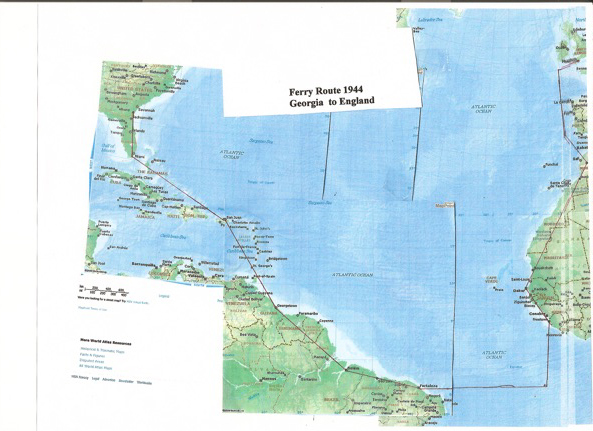
We arrived at our base in Bishop Stratford two days before “D” day. None of our crews participated in combat that day. The next day it was all out, of course, with experienced crews.
Note: Frank Carrozza was assigned to a crew and flew his first missions on June 4 and 5. He also flew two missions on D-Day.Missions for the days following ‘D’ day, were in support of disruption of German reinforcements to the beachhead. Our squadron’s assigned target was a bridge over a river at Lessary, France. Weather was real bad but we were told to hit the target. The clouds were so low that the flight was at 500 feet. German solders were shooting at the planes with rifles. As the formation approached the target, which was adjacent to a town, civilians were running out of town and going under the bridge for protection. The civilians thought that we were to bomb the town. The bombs destroyed the bridge. Planes following the initial formation were fearful of receiving damage from the exploding bombs that had just been dropped.
Our Bishop Stratford base was located 30 miles north of London. I made some trips to London but there was a lot of German activity with buzz bombs and V-2 rockets. Some buzz bombs got into our area. One morning when I woke up there was stored food on the floor that had been on a shelf. I ask what happened and was told that a buzz bomb landed close. I did not hear it.
The squadron lost more planes on take-off and landing than in combat. It was not uncommon to see a plume of black smoke when the formations were assembling. On one early mission, I was flying as co-pilot. When we broke ground the plane hardly had flying speed and was flying about 15 feet off the ground. I could see a church steeple in our path. I was wondering which side of the steeple was to be our track. Finally the pilot pulled the mixture control from full rich to automatic rich and the plane started climbing. The plane was drowning in fuel. Full rich was always used for take-off but something was wrong with the fuel connection.
On 29 June 1944 our target was a rail yard at Rouen, France. The weather was bad. There was a thunderstorm approaching Rouen from the west and the bombing formation was approaching from the east. The closer that the formation got to the target, the lower were the clouds. Since the formation was not maintaining a constant altitude, the Bombardier could not get the correct information into the bombsite for the bombs to hit the target. All the time the formation was picking up intense accurate antiaircraft fire. I looked out my window and the tracers looked like someone holding a water hose up in the wind. The tracers were arching just to the rear of my plane. Then an 88 shell exploded just off our aircraft nose. The bombardier and I were both hit with flack. The plane was still airworthy. The bombs had to be jettisoned. When we approached the base the wheels would not extend. The hydraulic pressure was gone. I hand pumped the gear down. When touchdown occurred, the right tire was flat. The plane swerved to the right off the runway. I pulled the emergency air bottle for breaking. The air bottle was ruptured. There was nothing to be done to stop the plane. A fire truck was parked adjacent to the runway. The plane headed for the fire truck and the truck backed up. The plane, as it slowed down, kept heading for the fire truck. Finally the fire truck got out of the way. The plane kept going until it reached a bomb storage area and did a 360 turn in middle of stored bombs. The plane was not repairable. I got the Purple Heart and DFC for my actions.
.
Flight operations went on in marginal weather. Take-off procedure was for each plane to roll on 15-second intervals. One plane would use the right side of the runway and the next plane used the left side. With that takeoff concept, some of the vortex from the propellers was reduced. One day, I before I started the take-off roll the plane ahead of me was lost in the fog. I did not know whether or not he had cleared the runway. The clouds continued up to 5,000 feet altitude. Thirty-six planes, at a 15 second interval, climbed through the clouds at a constant air speed and rate of climb. When the aircrafts cleared the clouds, the formation formed into the elements just as if it had occurred on CAVU weather. That was a lot on precision flying by many pilots. It was a little scary, hoping that all pilots were as proficient on instruments as I. The weather was bad when the group returned from that mission. Another base had to be used where we landed for an overnight stay. RON was in a castle without heat. We had cots and a blanket for cover, no mattresses.
As a practice, on take-off when I broke ground and retracted the wheels, I would lower the plane closer to the ground, thereby minimizing the vortex from the plane ahead of me. There was a nine inches clearance from the prop tips to the ground. Of course I was at least two feet off the pavement before I lowered the plane. The people in the tower thought that I was flying reckless and called me in to discuss the procedure. I never clipped the pavement.
One day, I was standing near the control tower. There was a squadron of planes leaving for a mission. On the take-off run, one plane broke ground early without obtaining full flying speed. I think that the pilot had the “up trim tab” rolled all the way up. The plane was about 10 feet up and not having obtained take off speed, his left wing drug the pavement. Apparently the pilot shut all power because the plane landed hard. It looked that the landing gear crushed. Crewmen jumped out of the rear of the plane. No one moved in the front. The rescue and fire truck sat. No one moved. A small flame appeared near the back of the cabin. The flame slowly enlarged. Finally, after what seemed to be 5 minutes, the fire truck drove up .The fireman climbed up on the outside to the cockpit. A bomb went off. The crew in the front of the plane and 3 firemen were killed. Death was due partially to inactivity on the firemen’s part.
Another day I was hanging out at the base operations building. Again, there were heavy clouds in the area. One pilot suggested that he and I take off and see how high the clouds were. I agreed and off we went. About 3000 feet in total overcast the pilot said, “uh oh, I forgot to set the gyro before take off.” He then proceeded to lock the gyro. We were in a 30-degree bank when he locked it. Of course the gyro thinks we are flying straight and level. I hit his hands off the controls and told him that I would fly the plane. I used the old style basic instruments of needle and ball, rate of climb and air speed to get us down. He did not thank me for saving his life. Of course I was thinking about myself and was thankful for all the time that I spent in the link trainer.
While at Bishop Stratford, I was sent on two R and R trips (Rest and Recuperate). The first one was in Wales. There was a resort hotel where we stayed. It was on the west coast of Wales. I did not take advantage of that visit; did not do any sight seeing nor shopping. There were some locals that visited the hotel to entertain the troops by played the piano, snacks and some dancing. I was going to expose my knowledge of classical music when I ask the pianist if she knew Beethoven’s fifth symphony. I liked it very much and ask if she would play it for me. She looked at me odd because she had just completed playing it and I did not recognize it. I did not make many brownie points with her but she graciously played it again.
The second R and R trip was more enjoyable. One of my original crewmembers, Lt. Sheperd, had relatives living in Edinburgh, Scotland. He made arrangement for us to visit in their home. Of course we took ration coupons and paid for the food purchases. While there I
Was able to visit some of the famed gardens and a castle that existed on a cliff near the south edge of the city. The family was very friendly and it was a joy to be with them.
HAROLD VERNON AIKEN
I did some sight seeing on my own out of Bishop Stratford. I took a day trip to Cambridge looking over the campus, waterways and gardens. I would enjoy going to school there. I wish that I could have extended my visits to places farther from the Base. I had to respect the flying schedule. The USO in Bishop Stratford was an entertaining place. Locals there were serving snacks, soft drinks and some music. There was a pool table that was always occupied.
On a mission that I was not on, the squadron was returning to base. Ceiling was about 500 feet and a lot of turbulence. The ground crews, awaiting return of the squadron, would play cards. This particular day, one of the ground crew members said that he needed to go to the toilet before the airplanes landed. The other crewmembers convinced him to wait for one more hand. As the formation approached the field, at 500 feet with lots of turbulence, one plane cut the tail off another plane in the formation. They both crashed immediately and two crews were lost. One plane took out the toilet that the crewmember had delayed visiting. I almost had a similar accident. To enter the landing pattern, number three plane (my position) moves under the formation and takes a position outboard of the element. My co-pilot was in control of the plane. He dropped down and started to slide over. I signaled him that I would take control of the plane. He had a bad habit of riding the controls. He would lean into the stick that would make the plane go down. To compensate he would roll up trim to make the plane climb. When he relinquished control to me, the up control took over. The plane started to climb into the formation. I kicked the rudder and lunged onto the up control. The plane slid out barely past the other planes.
In the latter part of Oct.1944 the group moved to Pointois, France I received a letter telling me that I was a father. Marian did not tell me what a hard time she had berthing Katy. I was a proud father and passed the word to anyone that would listen. At Pointoise we started out living in tents. Some former German barracks were being reworked and we were able to move in before Christmas. Mattresses for our use were salvaged from a German comfort station.
The squadron’s base was located about 30 miles north of Paris. When flying was not scheduled, trip to Paris was authorized. We would grab a truck and Charlie and take off to Paris. I got to do a lot of site seeing. I visited many of the national houses, parks and museums. My purchases were small, as I had no idea of things that Marian might want. I sent her some perfume. I took Charlie to see the Les Follies Bergere. It was an exciting time for him. The performers did not actually strip. The first performers were somewhat dressed. As subsequent performers appeared they had on fewer clothes. Charlie was letting out a whoop as each new performer appeared. By the time that the last performer appeared without any dress, Charlie was so loud that I was asked to take him outside. I think he really enjoyed that visit, as it was a lot different from his experience in Ireland.
It was apparent that God was looking out for me when a few days after the Battle of The Bulge began December 1944, an incident occurred. Our target was an ammunition storage area. The weather was bad. We had to bomb using a pathfinder plane as leader. (A pathfinder plane had secret radio equipment that tracked the planes location from at least two radio stations. When those tracks crossed the pathfinder plane dropped bombs. The following formation dropped on the lead plane’s drop.) There were 8 groups of 36 planes each assigned to bomb the area at about 15 minute’s intervals. Our group of 36 planes were the second group over the target. As we approached the area to head for the target, the first group was leaving. Our bombs were dropped without incident. As we left the target area the third group was approaching. Upon returning near the base there was a radio request. ”Did we have any fighter opposition?” We had not seen a German fighter. The first group lost 16 of the 36 planes to fighters. The third group lost 8 of the 36 planes. Why the second group was not attacked is a mystery.
For the most part, combat missions did not scare me. At one briefing the announcer said that there were 104 antiaircraft guns in place on the approach to the target. That briefing scared me. Take-off was delayed. Finally the announcement came that the mission would be flown the next day. I sweated the trip out all night long. Next day the crews assembled in the briefing room. We were told to wait for the weather to clear at the target. We waited all day. Another unsettled night. The third day the mission was canceled. I was happy.
Again, God was looking out for me. I had finished 55 missions and wanted to reach 65 so I could go home. I looked at the next day loading list (schedule) and I was not on it. Our squadron was putting up two flights so there were two number 3 positions (which is the position that I flew). I went to headquarters complaining that I wanted to fly. The response was that I had been flying a lot and needed a break. On that mission, both number 3 positions were shot down. I decided that I would not complain any more.
There was a pilot assigned to our squadron fresh from the states. It was the Instructor from Barksdale who was afraid to be with new pilots flying formation. I took him up on a training flight. He was flying as my copilot. I showed him the countryside, radio towers and the pattern that was used for landing. There was another plane in the area. I radioed him and told him that I would fly formation with him for a while. I moved in overlapping wings so close that my copilot could read the instruments in the other plane. He was silent but there was a strong odor in the cockpit. On the landing approach, I signaled for him to land the plane. He crossed the threshold a little high. The runway sloped and dropped down and the pilot didn’t. The plane was about 10 high when he was almost at a stall. I grabbed the controls and lowered the plane to make a smooth landing.
On 21 March 1945, I flew my last combat mission. I flew as co-pilot, training my regular co-pilot to man the aircraft. The squadron moved to Belgium. I flew some ferrying trips to the new base. Of course Charlie went along. I went to the local town often. I would order steak with eggs. Some of the crewmembers suggested that the steak came from horses, not beef. Never the less, the meat was enjoyable.
A message came to headquarters that a pilot had been shot down and taken care of by the Free French. He was in La Harve, France, and wanted to visit the base. I was assigned a Jeep and went to pick him up. I got to see much of the north coast of France. The roads were very bad. Tanks had ruined the pavement. It was a slow trip. When I got back, I had orders to head home. Left Charlie with the Dutch lasses. Don’t know how he made out, but knowing Charlie, he was having a time of his life.
I was on the dock in England ready to go home when Germany gave up, May 9, 1945. I got on the troop ship and headed out to sea. I made it for ½ day before I was seasick. The weather was bad. Our ship was part in a convey of ships because it was not certain that the German U-Boats had gotten the message of surrender. The sea was so rough that the propellers on the adjacent ships could be seen in the high waves. I lost a lot of weight on that trip. Finally, after about a month, I was able to stand on dry land in New York and eat a hamburger. I sent Marian a telegram saying that I would be home soon.
When I had finished my missions I had some time to spare. Looking back, I wish that I had looked up a fighter base and got checked out in a P51. That would have been a lot of fun. At that time it was not definitive that I would not be sent the Pacific. I would have preferred a fighter vs. a bomber to fight the Japanese: but dumb, me I did not consider all aspects of military. The rumor was that with 50 points and not in possession of a critical expertise, a discharge was probable. A month service was one point. An award of a metal was worth 5 points. I had 13 awards of the Air Metal, one award of the DFC and one award of the Purple Heart for a total of 75 points in awards. With all point, I still should have tried to get qualified in the P51.
Lt. Aikens’s Mission Log
Date Target Remarks
6-8-1944 Lessay Flak at Le Harve
6-10-44 Lo Ls bombed at 500 ft
. rec light arm fire
6-12-44 Conde sur
. Noireau Nothing identified
6-13-44 St Pierre Nothing identified
6-15-44 Leral Nothing identified
6-20-44 Belle de Hotesse No Ball
6-22-44 Cherauberg
. Mod accurate flack
. Fighters. Troups/frag
6-24-44 Beauvais Nothing identified
Oissel(Rouen)
. Purple Heart, DFC
. Intense accurate flack
7-7-44 Aborted over France
7-18-44 Caen Intense Accurate flack. Support British
7-24-44 Tours Intense Accurate flack. Plane damaged
. Emergency landing just behind beachhead
7-28-44 Bueil RR Bridge No flack
8-2-44 Lile Marshaling yard no flack
8-3-44 Bueil RR bridge Pathfinder no flack
8-13-44 Lisieux Bridge No flack
8-14-44 Lisieux Bridge No flack
8-16-44 Rouen Group aborted
8-27-44 Rouen Intense inaccurate flack
8-27-44 Leon Intense accurate flack
8-31-44 Ilse off
. St Malo Pathfinder No flack
9-1-44 Brest Strong point No flack
9-3-44 Brest Strong point No flack
9-5-44 Brest Strong point No flack
9-6-44 Brest Strong point No flack
9-10-44 Nancy RR bridge No flack
9-12-44 Nancy Troops no flack
10-7-44 Arnhem Hwy Br. Intense inaccurate flack
10-14-44 Mayen Window Inaccurate flack
10-29-44 Mayen RR Bridge No flack
11-11-44 Eschwesler Troups Mod acc flack
11-18-44 Pier (Duren) Window Intense Acc flack
11-26-44 Giessen Sortie aborted
11-26-44 Giessen Window. Moderate inaccurate flack
11-30-44 Giessen Intense accurate flack Pathfinder
.
Lt. Harold Aiken recently celebrated his 90th Birthday! We wish him all the best!
Here are some pictures showing his special cake and his celebration with Mrs. Aiken and sister Audrey.
